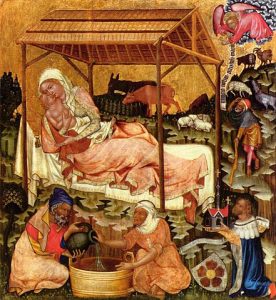Foundation of the Feast of the Nativity
 When and where did the keeping of Christmas begin? Many details of its early history remain in uncertainty, but it is fairly clear that the earliest celebration of the Birth of Christ on December 25 took place at Rome about the middle of the fourth century, and that the observance of the day spread from the western to the eastern Church, which had before been wont to keep January 6 as a joint commemoration of the Nativity and the Baptism of the Redeemer.
When and where did the keeping of Christmas begin? Many details of its early history remain in uncertainty, but it is fairly clear that the earliest celebration of the Birth of Christ on December 25 took place at Rome about the middle of the fourth century, and that the observance of the day spread from the western to the eastern Church, which had before been wont to keep January 6 as a joint commemoration of the Nativity and the Baptism of the Redeemer.
The first mention of a Nativity feast on December 25 is found in a Roman document known as the Philocalian Calendar, dating from the year 354, but embodying an older document evidently belonging to the year 336. It is uncertain to which date the Nativity reference belongs; but further back than 336 at all events the festival cannot be traced.
From Rome, Christmas spread throughout the West, with the conversion of the barbarians. Whether it came to England through the Celtic Church is uncertain, but St. Augustine certainly brought it with him, and Christmas Day, 598, witnessed a great event, the baptism of more than ten thousand English converts. In 567 the Council of Tours had declared the Twelve Days, from Christmas to Epiphany, a festal tide; the laws of Ethelred (991-1016) ordained it to be a time of peace concord among Christian men, when all strife must cease. In Germany Christmas was established by the Synod of Mainz in 813; in Norway by King Hakon the Good about the middle of the tenth century.
*******
From Clement A. Miles’ Christmas in Ritual and Tradition, Christian and Pagan (1912), edited by William Mackis.